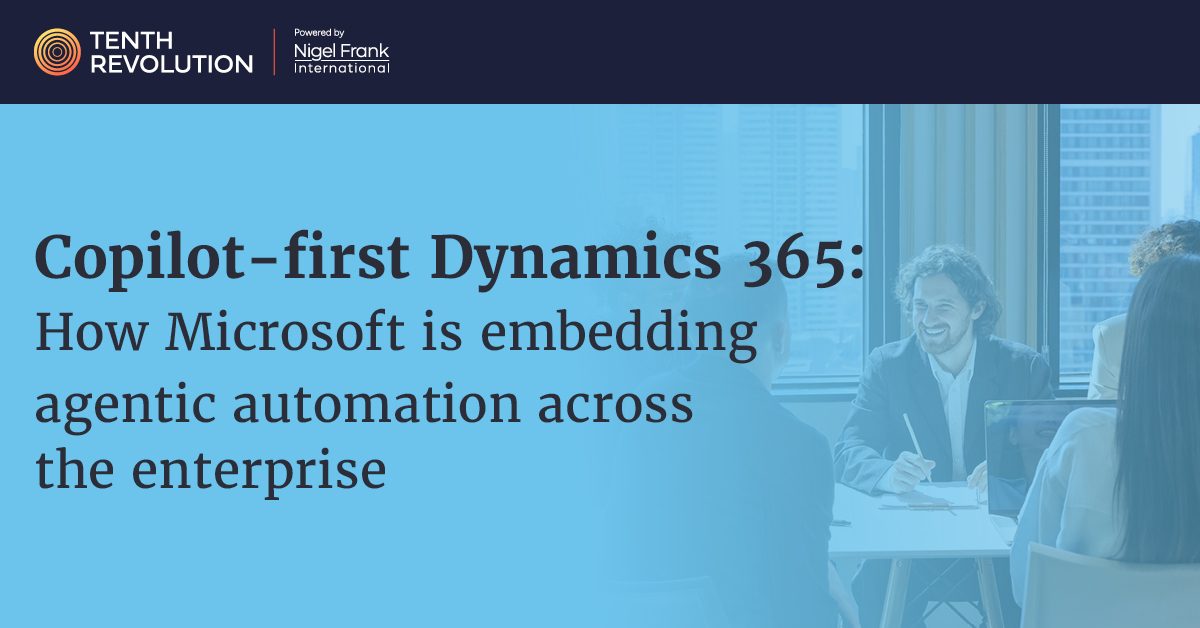
Executives evaluating Microsoft Dynamics 365 in 2025 are encountering a significant shift.
The platform is moving into a copilot-first model, where automation is no longer a bolt-on feature but a foundational layer embedded across every application. Sales, Service, Finance, Field Service, and Business Central are all seeing Microsoft Copilot and Copilot Studio become the standard way employees interact with their daily work.
This change reshapes the expectations placed on leadership teams. It affects how processes are managed, how staff are trained, and how organizations enforce governance. It also has direct implications for talent strategy. With hiring managers reporting that it now takes six and a half months on average to fill a Microsoft cloud role—a figure highlighted in Nigel Frank’s Microsoft Cloud Careers and Hiring Guide—the ability to make existing employees more productive with embedded copilots is not just a technology upgrade, but a workforce necessity.
From task assistance to autonomous action
When Microsoft first introduced Copilot in Dynamics 365, it was framed as a helper designed to lighten workloads by drafting emails, summarizing meetings, or surfacing relevant knowledge base articles. These functions saved time but did not fundamentally alter business outcomes.
That picture is changing. Today’s copilots act with more autonomy and tie directly to enterprise priorities. In Dynamics 365 Sales, Copilot can log activities, schedule meetings, and generate talking points based on account history. In Customer Service, it classifies cases, drafts responses, and escalates urgent issues before service levels are breached. In Finance, it scans transactions for anomalies, predicts risks, and initiates workflows for approval.
What began as assistance is now closer to delegation. Copilot is evolving into an embedded agent that maintains continuity, speed, and oversight across the enterprise.
A new mandate for executives
For business leaders, the transition to copilot-first Dynamics brings new responsibilities. Workflows are becoming proactive, as copilots surface issues before teams know to ask for them. Training expectations are shifting, with employees needing to validate and guide AI recommendations rather than just navigate system menus. Data governance has also risen to the top of the agenda, because copilots act on whatever information is available, and errors or gaps in that data can quickly ripple across decisions.
Copilot-first Dynamics is already changing how enterprises operate, but adoption depends on having skilled professionals in place. Nigel Frank works with organizations worldwide to deliver Dynamics 365 talent that can configure, extend, and manage copilots effectively.
Copilot Studio and the customization opportunity
A major development is Copilot Studio, which allows organizations to design and deploy their own copilots. Instead of relying solely on Microsoft’s prebuilt models, enterprises can tailor copilots to reflect industry needs and role-specific processes.
A manufacturer might create a copilot that schedules maintenance based on IoT sensor data and past work orders. A professional services firm could build one that drafts contracts, checks compliance clauses, and routes documents for approval. A retailer might design a copilot that predicts regional demand shifts and redistributes inventory before shortages occur.
This level of customization enables organizations to differentiate themselves without building bespoke solutions from scratch. It also raises demand for professionals who can bridge technical design with business knowledge — talent that is already scarce and commanding premium salaries across Dynamics roles.
A connected automation fabric
What makes the copilot-first model distinctive is how it stretches across applications. Because Sales, Service, Finance, Field Service, and Business Central now share a common AI and data fabric, copilots can coordinate actions across functions. A sales forecast can automatically update financial projections. Service insights can inform product development. Inventory adjustments in Business Central can trigger communications in Sales and Supply Chain.
For executives, this creates a more responsive enterprise where information moves in real time, not at the pace of reporting cycles. It also reinforces the need for cross-functional governance, since decisions in one department can instantly affect another.
Building readiness across people and processes
Adopting Copilot-first Dynamics requires more than enabling features. Leaders should prioritize three areas: strengthening data stewardship to prevent errors from spreading through automated decisions; building governance frameworks that define when copilots act independently and when human validation is required; and investing in change management so employees are trained to see copilots as partners rather than novelties.
Why timing matters now
Microsoft has made clear that future updates will embed automation by default, not as optional extras. Copilot-first Dynamics is quickly becoming the norm, and businesses that prepare now will benefit from reduced workloads, faster decision-making, and more capacity for strategy. Those who delay will struggle to catch up, especially as competitors fold copilots into their core operating models.
For leaders, the challenge is clear: Treat copilots as part of the leadership toolkit, not as background features. The enterprises that succeed will be those that align people, data, and governance to harness agentic automation at scale.




